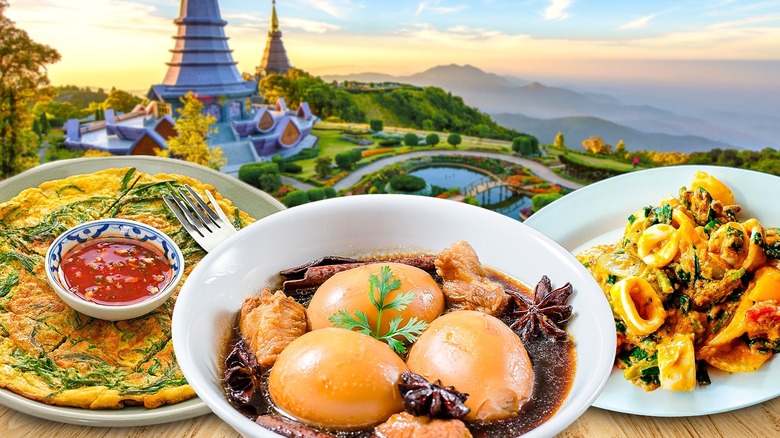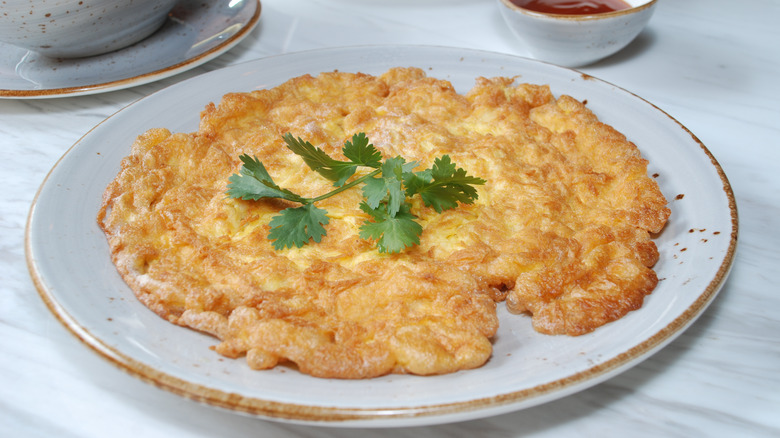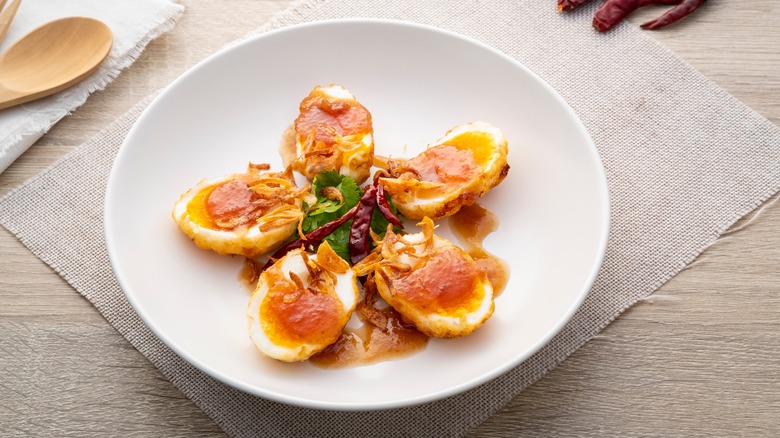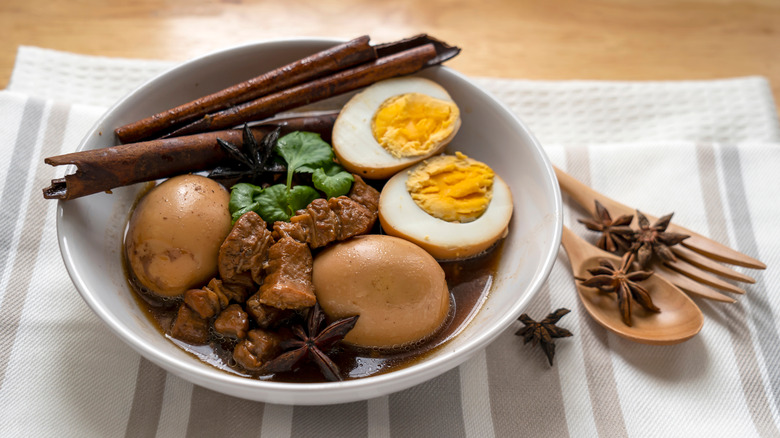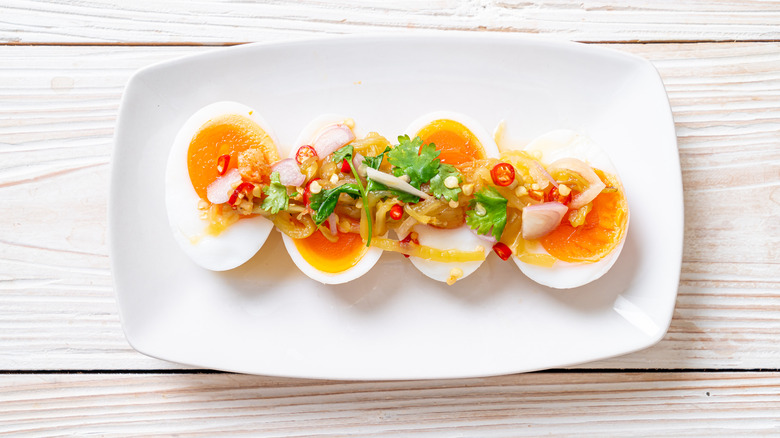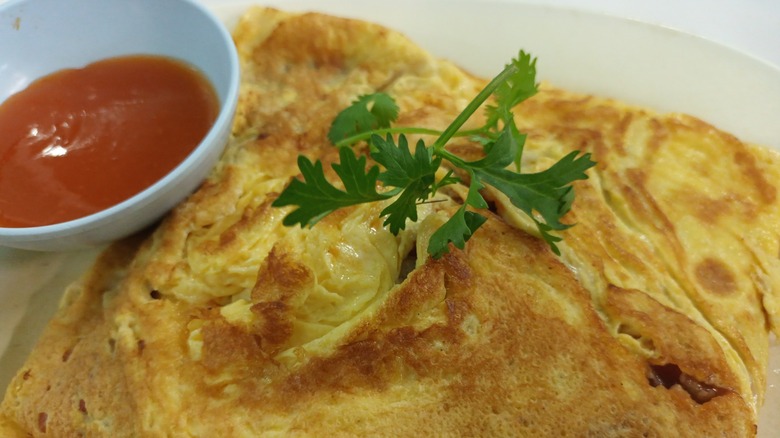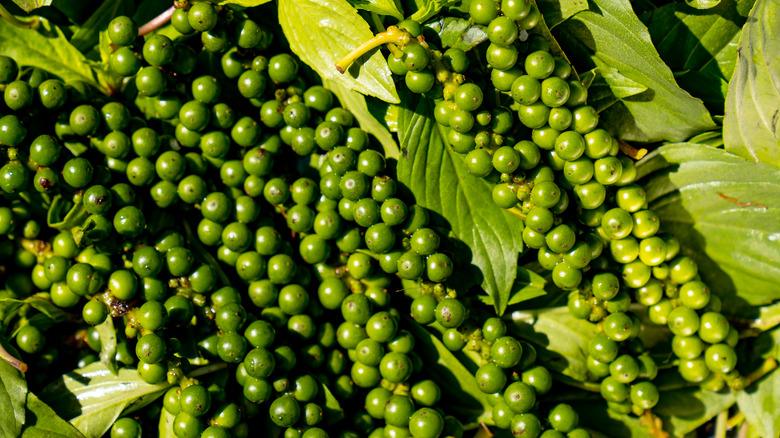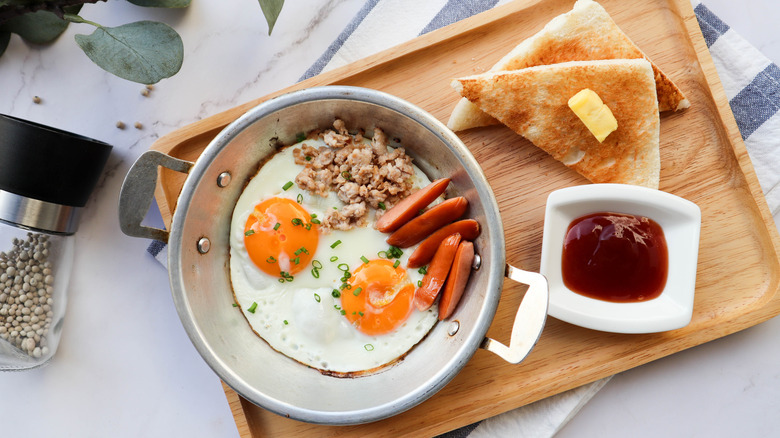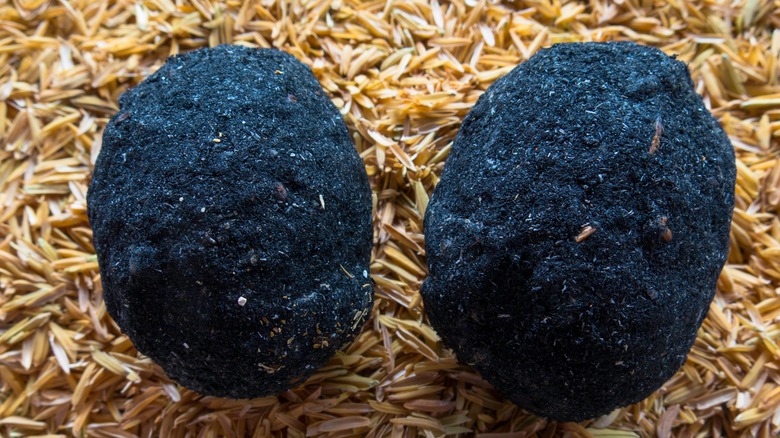9 Egg Dishes From Thailand You Should Try At Least Once
If you've ever eaten Thai food, you know that there's nothing quite like it. The combination of sweet, acidic, spicy, and fermented ingredients used in Thai cooking creates a dynamic, intricate flavor combination that has been delighting diners for hundreds of years. Although eggs might not be the first protein that comes to mind when you're thinking about Thai food, these mighty little protein-packed orbs feature heavily in the cuisine and their mild flavor and rich texture make them perfect for absorbing the bold flavors that it has to offer.
In fact, eggs have been consumed by humans for thousands of years in almost every corner of the globe, so it's not surprising that they made their way into Thai cuisine. They're also a great source of vitamins and nutrients. Although you might be used to eggs as a breakfast food, in Thailand, they're typically eaten at any meal as a side dish or a main course.
Many Thai egg dishes don't make it onto the typical menu at a Thai restaurant in the United States, but they're worth seeking out for an eggy adventure. We compiled this list after several months spent traveling around Thailand and trying many of these egg dishes for ourselves. Read on to find out about egg dishes from Thailand that you've got to try.
Kai jeow (Thai-style omelet)
Kai jiao is a Thai-style omelet, but it certainly isn't served alongside coffee and toast for breakfast. This delicious, pillowy egg dish is super simple, containing just eggs, fish sauce, some lime juice, and a dash of flour or cornstarch. But it's not just the ingredients that set kai jiao apart from your standard omelet, it's also the technique.
The key is to make your kai jiao crispy on the outside and fluffy on the inside, and you achieve that by heating some oil up over medium-high heat in a round-bottomed pan or, if you don't have one, go with a nonstick pan when making Thai omelets. Pour your egg mixture into the pan from a height of about 12 inches, which helps the mixture fluff up and create folds and ridges that get nice and crispy on the outside while the inside of the omelet remains soft. Kai jiao is often served as a side to complement a variety of Thai dishes or it can be the star of the show served on top of a bed of hot rice or rice porridge. If you like it spicy, squirting a bit if sriracha on top can turn up the heat and add a dash of extra flavor.
Kai look kuey (son-in-law eggs)
There's a myth behind the naming of Thai "son-in-law" eggs, known as kai look kuey in Thailand. Legend has it that a resentful mother-in-law served two of these boiled, deep-fried orbs to a man who was mistreating her daughter as a not-so-veiled threat that a certain pair of body parts could suffer the same fate if he didn't see the error of his ways. Whatever the origin, these eggs are a feast for the eyes and then for the tummy, and it certainly doesn't seem like punishment to help yourself to the burst of flavor that they deliver.
To make this deliciously menacing dish at home, boil eggs until the yolk is just a bit jammy, and then after you let them cool, drop them into a bath of sizzling hot oil until they turn golden-brown on the outside. Cut them in half and arrange them on a plate with the cut sides up and drizzle them with their signature sauce, a sweet, spicy combination of sugar, tamarind, fish sauce, and Thai chiles that gives them a sticky finish that contrasts with the savory crunch of the egg itself.
Kai palo (spiced stew with pork belly and eggs)
Thai food is all about a perfect union of intense flavors. Sweet, savory, and full of spice, kai palo, a stew made with hard-boiled eggs and pork belly, is a serious comfort food that will wrap your taste buds up in a warm embrace. Originally introduced by Chinese immigrants in Thailand, kai palo is flavored with five-spice, which is a hard-hitting combination of anise, fennel, cloves, ginger, and cassia bark, which is a relative of cinnamon.
A perfect kai palo starts with caramelized palm sugar, which coats the pork belly and gives the stew a sweetness that helps balance the intense flavor of the five-spice. The eggs are hard-boiled, peeled, and added to the sauce just before the water and spices go in. The whole mixture is simmered together with soy sauce, which lends kai palo an intensely savory umami taste until the eggs absorb some of the flavors from the broth and turn a brown-tan color on the outside. It's a surprisingly easy dish to make at home once you gather all the ingredients and it's definitely worth the payoff.
Yum kai tom (Thai-style egg salad)
It's a well-known summer staple, but if you're looking to elevate egg salad to a whole new level, you've got to try yum kai tom, a Thai-style egg salad that packs a salty, tangy, funky flavor punch compared to its American cousin. Like a lot of Thai dishes, it's fresh and light and doesn't get bogged down with heavy ingredients. You can make yum kai tom with hard or soft-boiled eggs depending on your preference, but the key to making the dish sing is the dressing.
Shallots, sugar, lime juice, and fish sauce form the base of the dressing, and depending on how brave you're feeling, you can add a few bird's eye chilis, which are small peppers commonly used in Southeast Asian cuisine that are about 10 times hotter than jalapeños. If you want to retain the flavor of the bird's eye, but cut down on the heat, remove the seeds, but do so carefully and avoid touching it directly as it can irritate your skin. After you've arranged your boiled eggs on a plate with the cut side facing up, spoon some dressing over the eggs and get ready for an eggy taste explosion — Thai style.
Kai yad sai (stuffed omelet)
If you're looking for a massive dose of protein dressed in a spicy, tangy flavor that will make your mouth water, then look no further than kai yad sai, which is Thai for "stuffed eggs." Eaten for lunch or dinner, the eggs in kai yad sai are cooked into a thin sheet that resembles a crepe and loaded with ground pork that is seasoned with garlic, lime juice, fish sauce, and sugar, among other things, to create a savory, tangy, umami combination that's just a tad sweet.
The key to getting your eggs nice and thin is to add a bit of water to the egg mixture so that it spreads out in the pan. Once it's cooked, remove it from the pan, put a small pile of ground pork in the center, fold the sides of the omelet over the center, and then flip it upside down so that the smooth side of the omelet is on top. To plate it up as they do at restaurants in Bangkok, slice an X shape in the eggs with a knife so that you can see just a bit of pork and serve it hot alongside a steaming pile of jasmine rice.
Kai prik (pepper eggs)
If you like pepper, then you'll love kai prik. Although most of the world's black pepper comes from India, this distinctly pungent spice has been a part of Thai cooking for millennia. Although we're used to using dried peppercorns in the United States because pepper is cultivated in Thailand, it's easier to get your hands on the fresh, green variety of peppercorn that is used in kai prik, or "pepper eggs," an egg dish that prominently features the spice. Green peppercorns are the unripe berries of the pepper plant that are harvested earlier and have a milder, fresher taste than black pepper. Eggs, with their neutral flavor profile, are a perfect way to showcase the unique taste that green pepper has to offer.
To make kai prik, start by scrambling eggs in a pan with some oil until they are just beginning to set. From there, mix in some sugar, fish sauce, soy sauce, ground black pepper, hot chilies, and green peppercorns. Sauté the whole mixture together until the outside of the green peppercorns begin to look a bit shiny, and plate it up. You can serve it up with a plate of jasmine rice, which helps balance out the intense, peppery aroma of the eggs.
Kai grata (pan eggs)
If you've ever been to a breakfast restaurant and ordered a skillet full of eggs, cheese, and meat, then you're at least somewhat familiar with the concept of kai grata, which literally translates to "pan eggs," because they're cooked and served in a pan. Kai grata is packed with meat and spicy flavor and is a street food and is common in the northern and northeastern regions of Thailand, where you can get it on the roadside or at a stall in a market.
The eggs in kai grata are fried with the yolks still intact and while they're cooking, you top them with meat. Although just about any meat will do, we recommend you make some minced pork with spices, a preparation common in a lot of Thai dishes, and some Chinese sausage, or lap chong, which is a pork sausage preserved with sugar and soy sauce. Cover your pan to make sure the eggs cook properly and then serve it up with some chopped scallions.
Kai kem (salted eggs)
Kai kem, or salted eggs, were originally developed as a way to extend the relatively short shelf life of eggs, but their unique rich, briny flavor is enjoyed in Thailand by many a foodie. Traditionally, kai kem was prepared by burying duck eggs in a mixture of salt and clay, letting them sit for a couple of days, and then tossing them in rice husks or vegetable ash to prevent them from sticking to one another. After they've gone through this process, they're good to eat for 15 to 20 days.
In most modern kitchens, however, the eggs are preserved by soaking them in a salty brine for a few weeks. Both preparations will leave you with a truly unique texture and flavor experience. The white of the eggs becomes dense while the yolks get chalky and crumbly and a salty, briny flavor permeates every bite. They can be eaten on their own, used in salad, or served as a side to a meal. You can use chicken eggs, but duck eggs are more common because the yolk is larger, fattier, and more robust, and let's be honest — that's the best part.
Yam kai dao
To make yam kai dao, or Thai-style spicy egg salad, you've go to throw away your ideas of what egg salad should be. Instead of boiled eggs covered in a heavy base of mayonnaise, this egg salad is made with crispy fried eggs that are dressed in a sauce that showcases the spicy, sweet sensory experience that Thai food is famous for. The trick to cooking fried eggs for yam kai dao is to get them nice and crispy, which you can achieve by heating up oil in a pan over medium-high heat, enough to make the egg whites sizzle when they hit it and cook just until the bottom is golden brown and the yolk is still runny. You can spoon some hot oil over the egg whites to make sure they cook all the way through.
Once you've let the eggs cool on a paper towel to absorb the extra oil. Next, prepare the dressing, featuring sugar, lime juice, lemongrass, hot chili peppers, and fish sauce, which gives yam kai dao and distinctly funky, umami taste. Although you can eat yam kai dao on its own or with some jasmine rice, it's usually served alongside other dishes as a part of a meal.
